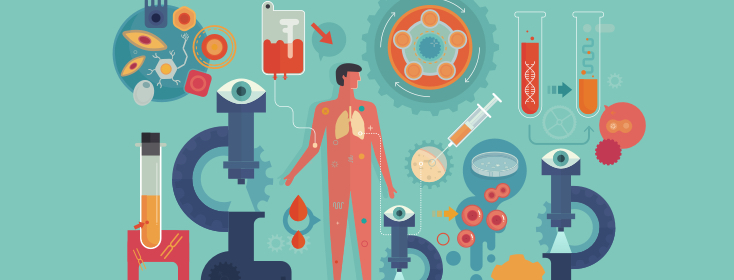To Biopsy or Not to Biopsy, That is the Question!
I have had four biopsies since I was diagnosed with lung cancer in 2013. Why so many biopsies? Well, each one was done at a particular time in my treatment path to learn more about the exact molecular composition of the type of lung cancer I have. As a result, these biopsies helped my oncologist decide upon the best treatment that would work for me.
The first on many biopsies
My first biopsy was a bone biopsy taken from my elbow, in order to determine whether the bone mass that was found on an MRI was cancerous or benign. The orthopedic oncologist I was seeing at the time thought that it would turn out to be benign, but lo and behold, the results came back as adenocarcinoma. This result set me on the path to discovering that I had lung cancer.
Since adenocarcinoma doesn’t originate in the bone, the biopsy results told my doctor that the mass in my elbow was a metastasis from another location in my body. I had a PET scan and found out that site was my lungs. The same biopsy tissue was then tested to see if I had a specific lung cancer mutation. In 2013, the only mutations I was tested for were EGFR, ALK and KRAS. Finding out that I had an EGFR exon 19 mutation made my treatment with targeted therapy possible.
This all happened because of the bone biopsy from my elbow, which was a fairly simple procedure.
Confusing results
After almost three years of treatment with my first targeted therapy, my oncologist started to see some slight progression in my lungs. By now, blood biopsies had been developed so I had one of these, which simply involved taking a few extra vials of blood at my appointment. My blood biopsy result showed that I had no mutations whatsoever, not even my original EGFR exon 19. How could this be?
My oncologist believed that some form of mutation was causing my progression even though it wasn’t showing up on the blood biopsy results. Since my progression was very slow, she watched my scans carefully over the next few months until there was a large enough area of progression in my lungs for a lung tissue biopsy. While I wasn’t exactly thrilled about having a needle placed in my lung, I agreed to the procedure because I knew that the findings could dramatically affect my future treatment.
I checked into the hospital in the early morning for an outpatient day procedure and actually had two biopsies — a second blood biopsy and then the lung tissue biopsy. Fortunately, I had no complications and went home that afternoon.
Testing for thousands of mutations with one test
After a two week wait, the lung tissue biopsy results showed that I had a T790M mutation, which made it possible for me to start on a new targeted therapy. I have now been on this treatment for 1 1/2 years. This time, my tissue was tested using NGS (next generation sequencing) which means than it was tested for thousands of possible mutations, as opposed to just the three that were tested for in 2013.
Ironically, my second blood biopsy came back completely negative as well, providing my oncologist with important information about the nature of the tumor in my lung — it wasn’t shedding cells or DNA into my bloodstream. The progression was just limited to my lung.
Dealing with false negatives
Luckily, my oncologist did not stop testing when I had a negative blood biopsy. It is important to realize that while blood biopsies are easy and convenient, they can frequently have false negative results. If this happens, patients should push their oncologists for tissue biopsies if safely possible! If I hadn’t had the fourth biopsy, my treatment today would likely be very different!
If and when I develop progression on my current treatment, I will definitely have further testing through biopsies. There’s an incredible amount of information that can be gathered through these procedures!
Editor’s Note: We are extremely saddened to say that on June 23, 2024, Ivy Elkins passed away. Ivy’s advocacy efforts and writing continue to reach many. She will be deeply missed.

Join the conversation